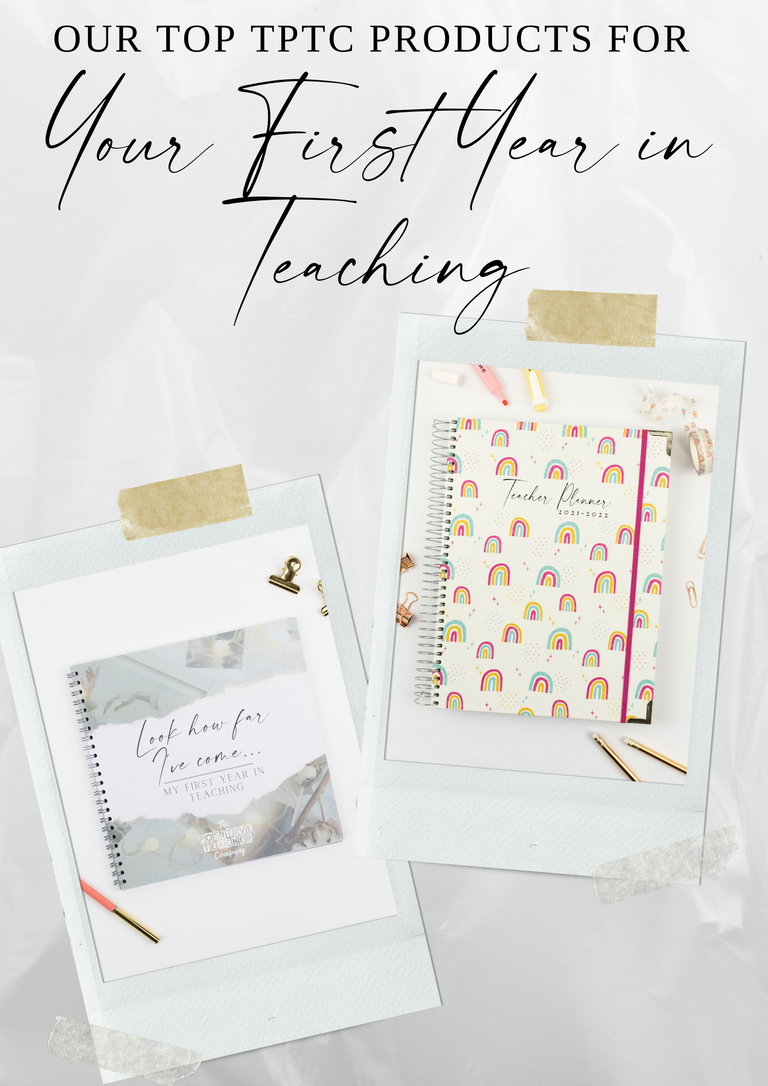When you’re a trainee teacher, you have a LOT to manage. There’s all of your learning, teaching practice, learning both the curriculum and behaviour management techniques, gathering evidence of your own learning, adapting to your school placement, essays and deadlines… so we designed the Teacher Training Planner to help you manage all of that. There’s a lot included, so today we’re sharing with you 6 ways to hack your teacher training and stay organised with our Teacher Training Planner!
Who’s the Teacher Training Planner for? It’s ideal for students who are doing multiple placements, like if you’re studying for a PGCE. The full year is covered so it doesn’t matter when your placements happen or how long they are, but there are enough planning pages to cover three different placements with key info and reflections. If you’re spending your training year based in one school, like SCITT, then we recommend a combo of the full Teacher Planner and the New to Teaching Essentials book. The essentials book contains useful trainee pages like mentor meeting notes and the ITT/ECT framework, while the full teacher planner works better for staying in one school setting for a full year.
Find our Teacher Training Planners here
Hack #1 – Manage your mentor meetings
Our Teacher Training Planner has lots of dedicated pages for mentor meetings, which you’ll be having regularly. Your training provider probably requires you to write up your mentor meetings in a specific format, so your planner is just for you. Hack your mentor meetings by using these pages to note down anything you want to bring up in your meeting – if you think of a question, issue, or idea, pop it down on this page so it’s there ready for you when you have your meeting! You’ll likely have actions or targets set at each meeting, and your mentor may ask you what you’ve done about these since your last meeting, so you can pop those notes in here when you do them so you know you’ll have an answer ready. Sure, you can use these pages to take notes during your meetings, but take it to the next level by using them to plan out your meetings and make sure everything gets covered!

Hack # 2 – Stack your spinning plates
Our Placement Overview pages are a great way to keep lots of key information all in one place – don’t overlook them, they’re secretly the most important pages in your Teacher Training Planner! You’ll have a lot of spinning plates to manage: both your in-school responsibilities, and your workload from your training provider, so use your overview pages to track everything in one place. You can label each row with week 1, week 2, etc. and use the columns for different things. Many teacher training courses set up different expectations for each week, like how much teaching responsibility you should have and specific tasks you need to do each week. Plus, you’ll have to consider what’s going on in your school, like the planning and any special events like sports day or World Book Day. Put it all here in one place! Then each week, all you’ll need to do is check this one page to see what you need to get done this week to meet all of your responsibilities.
Hack #3 – Engage with the ITT Framework
Your Teacher Training Planner contains the full ITT framework – that’s the different standards set for teachers – as well as notes pages. You’ll be referring to this regularly throughout your training, so it’s handy to have in your planner ready to refer to. But to really hack your teacher training, we encourage you to make notes, highlight it, underline it, and add your own ideas. If you do something that meets one of the standards, note it down. If you’re reading it and you have an idea for what you could do to show you’re meeting the standard, write it down! Really make these pages work for you by noting down ways to apply these standards and show you’re meeting them. Then you can always refer back to your notes and use them to structure your evidence folder.

Hack #4 – Observations? Sorted.
There are 2 different kinds of observations when it comes to teacher training, and you’ll need to make notes about both of them: having your teaching observed by others, and taking the opportunity to observe someone else’s teaching. Our planner has specific notes pages for both of these! It’s likely that your training provider will require you to fill out observation notes in a specific format, but we suggest utilising these pages to prepare for that. You might get the chance to observe someone else without much notice, or when you don’t have time to properly write it up, so it’s handy to have these notes pages always ready to go in your planner, in a place that’s easy to refer back to later – you don’t want them scattered across various notepads or (gasp!) loose pieces of paper. You can then refer back to these notes later when you have a moment to sit down and write it up more formally.
Our observation pages also guide you to help you really get the most out of what you’re seeing, which is especially helpful at the start of your training when you might not be so sure what you’re looking at. For when you get your teaching observed, these pages are great for reflection. You can quickly grab your planner and write your reflections on how the lesson went, and you can also reflect on the feedback you’ve been given. Again, these pages are just for you to get all your thoughts out in whatever messy, unstructured way works for you! Then you can always use them again later for a formal write up.
Hack #5 – Track your reading
Our planners include a ‘Books I’ve Read’ page – we’re bookworms here at TPTC and we know many teachers are too. Lots of teachers use this page to track the reading they do in their spare time, and that’s what you could do too, but you’ll likely be reading a lot of teaching-related books during your training so you could track it all here! We know many trainee teachers like to pick up books outside of the recommended reading, either for subjects they’re particularly interested in, or for more practical advice. There are a lot of great teaching books out there – click here to see some of our recommendations. You could colour code your books by colouring in the spines – maybe by topic, or rating, or whether they were required for your course or something you chose. We find filling this page out really gives a sense of accomplishment, which is always a positive thing during your teacher training!
Hack #6 – Colour code your year
At the start of the Teacher Training Planner you’ll find a whole year overview! We suggest colour coding your year to give you a great visual picture of what your year looks like. You could use different colours for each placement, for weeks you’ll be having lectures or tutoring in person, and for deadlines. This activity in itself can help you feel more prepared to start your training, as you’ll get your head around what your course looks like and where your time will be spent. Then it’s helpful to refer back to throughout the year, especially during busy periods when you want to make sure you have time to stay on top of the workload, or if you have some personal things you need to plan at a good time.
For more inspiration on how to use our Teacher Training Planner, read our guide here! Find the Teacher Training Planners here.



